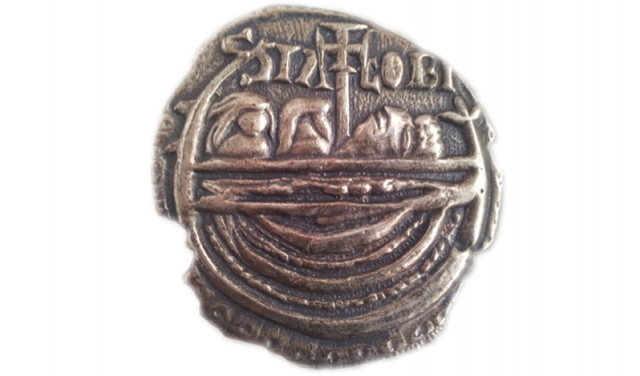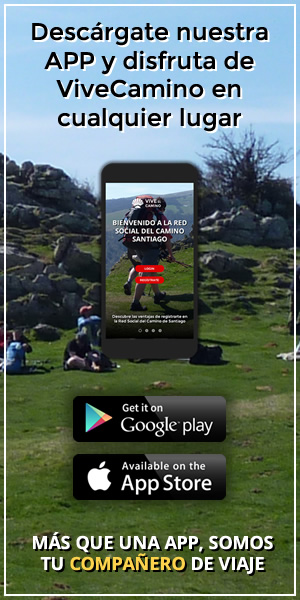From O Grove or Ribeira to Padrón, it mimics the route taken by boat with the remains of the Apostle

La moneda de Adro Vello mide 13 milímetros de diámetro y está hecha de una aleación de plata y cobre. Data del reinado de Fernando II (1157-1188), impulsor de la construcción de la catedral de Santiago
Christian tradition speaks of the evangelization task undertaken by the Apostle Santiago in ancient Roman Hispania. It was here that his remains arrived, transported by boat under the crew of the disciples Athanasius and Theodore in the first century.
How did this occur? And, why in Galicia? Santiago the Great, son of Zebedee, began his Apostle work in Jerusalem following the death of Christ. After this he reached the southern coast of the Iberian Peninsula, in order to continue north, to Iria Flavia (currently known as Padron).
However, upon his return to the Holy land a tragic end awaited him, under the order of Herod Agrippa I: decapitation, his crime was that of violation of the prohibition of Christian preaching. His faithful disciples stole the body of their master and set sail for Hispania in order to fulfil the orders of Saint Jerome: for each apostle to rest in peace in the farthest province from where they had once preached the Gospel.
The Camino route of Arousa and of the river Ulla are a memory to these last miles sailed with the remains of the apostle until disembarking in Padron, and from there on land for the almost 25 kilometres that remain to Compostela, a bearable distance to travel in one day. The ports of Ribeira and O Grove are the largest entry points to the Galician estuary and the first seen by the boat carrying the remains of the apostle, at this time they would still have to sail 40 miles to reach the ancient land of Iria Flavia, to the no longer existent port of Murgadán.
This journey provoked the recovery of the route by the Jacobean foundation, the entity that grants, along side other councils, the Traslatio Xacobea, the Compostela or its equivalent to all those who sail following the trail left by the Apostle. In summary, the amphibious journey consists of 40 miles by sea and river, to Padron and, from this location a further 25 kilometres by foot to Santiago of Compostela.
Sealing the nautical card and the voyage by sea
The points of departure are in the port of Pedras Negras (black stones) of O Grove or in Ribeira, although, it is clear that boats arriving from other distant locations also receive Jubilee recognition. In fact there are several nautical points where sailors can receive the seal for their nautical card along this sea and river route. They are Ribeira, O Grove, Boiro, Cambados, Rianxo, Pobra do Caramiñal, Dodro, Pontecesures, Sanxenxo, Ribadumia, Padron and Santiago of Compostela.
The majority of councils validate the credential in the municipal offices or at the local tourist offices. The main disadvantage of this nautical route, for those pilgrims without their own vessel, is the need to rely on companies that provide this transport service. Some tourism companies offer routes in catamaran and cover the Jacobean itinerary, they normally only sail during summer months and are conditioned by the sea tides that allow them to embark and disembark at the river bank. In addition, the boat trips normally require a minimum 20 people and cost 35 euros per person. There also exists the possibility to hire private taxi boats in the ports of Ribeira and O Grove.
Routes
Blog
 How to get to Sarria to do the Camino de Santiago
How to get to Sarria to do the Camino de Santiago
 Descubre la magia del Camino de Santiago Portugués por la costa
Descubre la magia del Camino de Santiago Portugués por la costa
 5 tours culturales que puedes hacer en Galicia si decides hacer un alto en el camino
5 tours culturales que puedes hacer en Galicia si decides hacer un alto en el camino
 Doing the Camino de Santiago in June: What you should know?
Doing the Camino de Santiago in June: What you should know?
Information
Points of interest
Cities & Towns | Hostels | Lodgings | Restaurants | Saddlery | Doctors | Points of interest | Bikes workshop
Contact us | Privacy policy | Cookies policy | | Terms of use | Authorship | Web Map | Consentimiento
© Copyright LA VOZ DE GALICIA S.A. Polígono de Sabón, Arteixo, A CORUÑA (ESPAÑA) Inscrita en el Registro Mercantil de A Coruña en el Tomo 2438 del Archivo, Sección General, a los folios 91 y siguientes, hoja C-2141. CIF: A-15000649
Developed and managed byHyliacom
